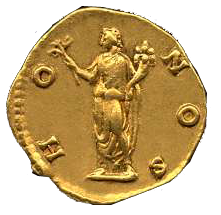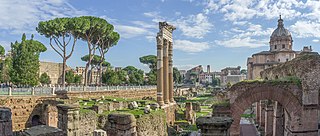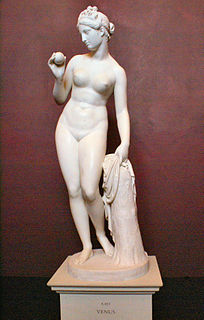
Venus is a Roman goddess, whose functions encompass love, beauty, desire, sex, fertility, prosperity, and victory. In Roman mythology, she was the ancestor of the Roman people through her son, Aeneas, who survived the fall of Troy and fled to Italy. Julius Caesar claimed her as his ancestor. Venus was central to many religious festivals, and was revered in Roman religion under numerous cult titles.

The Quirinal Hill is one of the Seven Hills of Rome, at the north-east of the city center. It is the location of the official residence of the Italian head of state, who resides in the Quirinal Palace; by metonymy "the Quirinal" has come to stand for the Italian president. The Quirinal Palace has an extension of 1.2 million square feet.

Honos or Honor was the Roman god personifying honor. He was closely associated with Virtus, the goddess of manliness, or bravery, and the two are frequently depicted together. Honos is typically shown wearing a chaplet of bay leaves, while Virtus is identified by her helmet.

The Capitolium or Capitoline Hill, between the Forum and the Campus Martius, is one of the Seven Hills of Rome.

The Capitoline Triad was a group of three deities who were worshipped in ancient Roman religion in an elaborate temple on Rome's Capitoline Hill. It comprised Jupiter, Juno and Minerva. The triad held a central place in the public religion of Rome.

The Temple of Jupiter Optimus Maximus, also known as the Temple of Jupiter Capitolinus was the most important temple in Ancient Rome, located on the Capitoline Hill. It was surrounded by the Area Capitolina, a precinct where numerous shrines, altars, statues and victory trophies were displayed.

The Temple of Caesar or Temple of Divus Iulius, also known as Temple of the Deified Julius Caesar, delubrum, heroon or Temple of the Comet Star, is an ancient structure in the Roman Forum of Rome, Italy, located near the Regia and the Temple of Vesta.

The Imperial fora are a series of monumental fora, constructed in Rome over a period of one and a half centuries, between 46 BC and 113 AD. The fora were the center of the Roman Republic and of the Roman Empire.

The Temple of Saturn was an ancient Roman temple to the god Saturn, in what is now Rome, Italy. Its ruins stand at the foot of the Capitoline Hill at the western end of the Roman Forum. The original dedication of the temple is traditionally dated to 497 BC, but ancient writers disagreed greatly about the history of this site.

The Temple of Venus Genetrix is a ruined temple in the Forum of Caesar, Rome, dedicated to the Roman goddess Venus Genetrix, the founding goddess of the Julian gens. It was dedicated to the goddess on September 26, 46 BCE by Julius Caesar.

The Gardens of Sallust was an ancient Roman estate including a landscaped pleasure garden developed by the historian Sallust in the 1st century BC. It occupied a large area in the northeastern sector of Rome, in what would become Region VI, between the Pincian and Quirinal hills, near the Via Salaria and later Porta Salaria. The modern rione is now known as Sallustiano.

The Forum of Caesar, also known by the Latin Forum Iulium or Forum Julium, Forum Caesaris, was a forum built by Julius Caesar near the Forum Romanum in Rome in 46 BC.

Sulpicia was the wife of Quintus Fulvius Flaccus, and earned everlasting fame when she was determined to be the most chaste of all the Roman matrons.

The Fasti Capitolini, or Capitoline Fasti, are a list of the chief magistrates of the Roman Republic, extending from the early fifth century BC down to the reign of Augustus, the first Roman emperor. Together with similar lists found at Rome and elsewhere, they form part of a chronology referred to as the Fasti Annales, Fasti Consulares, or Consular Fasti, or occasionally just the fasti.

The Temple of Jupiter Feretrius was the first temple ever built in Rome. Its site is uncertain but is thought to have been on the Capitoline Hill.
The Temple of Ops was a minor temple on the Capitoline Hill in Rome. It was dedicated to Ops, the deity of abundance.
The Temple of Fides was a minor temple on the Capitoline Hill in Rome. It was dedicated to Fides, the goddess of good faith, who was patron of diplomatic relations.

The Temple of Venus Erycina was an ancient sanctuary on the in Ancient Rome, erected in 184 BC and dedicated to the goddess Venus.

The Regio VIII Forum Romanum Magnum is the eighth regio of imperial Rome, under Augustus's administrative reform. Regio VIII took its name from the Roman Forum, the political centre of Ancient Rome.


















